#Data Science with Generative AI Online Training
Explore tagged Tumblr posts
Text
Data Science With Generative Ai Course Hyderabad | Generative Ai
The Evolution of Data Science: Embracing Artificial Intelligence
Introduction:
Data Science with Generative Ai Course, a multidisciplinary field that bridges statistics, programming, and domain expertise, has grown exponentially over the past few decades. Its evolution has been profoundly shaped by the integration of artificial intelligence (AI), driving groundbreaking advancements across industries. This article explores the journey of data science, the role of AI in its development, and tips to harness the power of this synergy for future success.
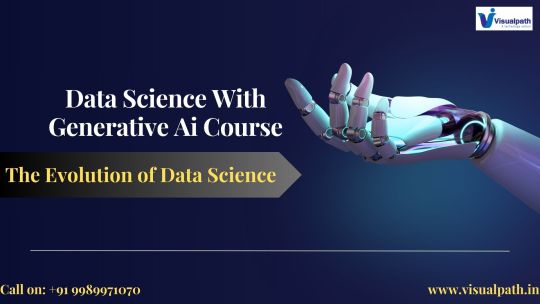
The Genesis of Data Science
In its early days, it focused on extracting insights from structured data, often using traditional tools like spreadsheets and statistical software.
From Statistics to Data Science: Initially, data science was synonymous with data analysis. The introduction of machine learning (ML) algorithms began transforming static analyses into dynamic models capable of predictions.
Big Data Revolution: The early 2000s saw an explosion of unstructured data due to social media, IoT, and digital transformation. The rise of Big Data technologies, like Hadoop and Spark, enabled businesses to process and analyze massive datasets, marking a pivotal point in the evolution of data science.
AI as a Game-Changer in Data Science
Artificial intelligence has redefined data science by introducing automation, scalability, and improved accuracy. AI's capabilities to learn from data, identify patterns, and make decisions have expanded the possibilities for data scientists.
Key Contributions of AI in Data Science
Enhanced Predictive Modeling: AI algorithms, particularly ML, enable the creation of sophisticated models for forecasting trends, behaviors, and outcomes.
Automation of Repetitive Tasks: AI tools streamline data preprocessing tasks, including cleaning, normalization, and transformation.
Improved Decision-Making: By leveraging AI, organizations can derive actionable insights faster and with greater precision.
Natural Language Processing (NLP): AI-powered NLP has revolutionized text analysis, sentiment detection, and language translation.
Image and Video Analytics: Computer vision, a subset of AI, enhances data science applications in industries such as healthcare, manufacturing, and security.
The Synergy of Data Science and AI
The integration of AI has led to the rise of data science 2.0, characterized by real-time analytics, advanced automation, and deep learning.
AI-Driven Analytics: AI complements traditional data analysis with deep learning, which identifies complex patterns in data that were previously unattainable.
Smart Tools and Frameworks: Open-source libraries like TensorFlow, PyTorch, and Scikit-learn have democratized AI, making it accessible for data scientists.
Data Science in the Cloud: Cloud platforms, combined with AI, have enabled scalable solutions for storing, processing, and analyzing data globally. Data Science with Generative Ai Online Training
Industries Transformed by Data Science and AI
Healthcare
Personalized Medicine: AI models analyze patient data to recommend tailored treatments.
Disease Prediction: Predictive models identify potential outbreaks and individual risk factors.
Medical Imaging: AI supports diagnostics by analyzing X-rays, MRIs, and CT scans.
Finance
Fraud Detection: AI systems identify anomalies in transactions, reducing financial crime.
Algorithmic Trading: AI optimizes stock trading strategies for maximum profit.
Customer Insights: Data science aids in understanding customer behaviors and preferences.
Retail and E-commerce
Recommendation Systems: AI analyzes purchase patterns to suggest products.
Inventory Management: Predictive analytics ensures efficient stock levels.
Customer Sentiment Analysis: NLP tools assess feedback for service improvements.
Manufacturing
Predictive Maintenance: AI monitors equipment for signs of failure.
Quality Control: Automated systems ensure product standards.
Supply Chain Optimization: Data-driven decisions reduce operational costs.
Challenges in the Data Science-AI Nexus
Data Privacy Concerns: Handling sensitive data responsibly is critical to maintaining trust.
Bias in AI Models: Ensuring fairness in algorithms is a pressing issue.
Talent Gap: The demand for skilled professionals in both data science and AI far exceeds supply.
Ethical Dilemmas: Decisions driven by AI can raise questions about accountability and transparency.
Future of Data Science with AI
The future of data science will continue to be shaped by AI, emphasizing the importance of continuous learning and innovation.
Democratization of AI: User-friendly tools and platforms will enable more individuals to utilize AI.
Interdisciplinary Collaboration: Merging expertise from fields like biology, economics, and engineering will yield holistic solutions.
Edge AI and IoT: Real-time analytics at the edge will become increasingly common in IoT applications. Data Science with Generative Ai Training
Explainable AI (XAI): Efforts to make AI models transparent will grow, enhancing trust and usability.
Tips for Leveraging Data Science and AI
Invest in Lifelong Learning: Keep up with advancements in AI, data science tools, and techniques.
Adopt Scalable Technologies: Utilize cloud platforms and AI frameworks for efficient workflows.
Focus on Ethics: Prioritize fairness, transparency, and privacy in your AI-driven initiatives.
Conclusion
The evolution of data science has been profoundly influenced by the integration of artificial intelligence. Together, these technologies have opened up unprecedented opportunities for innovation, efficiency, and growth across industries. While challenges persist, the future of data science with AI promises a world where data-driven decisions are not just insightful but transformative. By embracing continuous learning, ethical practices, and interdisciplinary collaboration, individuals and organizations can fully harness the potential of this powerful combination.
Visualpath Advance your career with Data Science with Generative Ai Course Hyderabad. Gain hands-on training, real-world skills, and certification. Enroll today for the best Data Science with Generative Ai. We provide to individuals globally in the USA, UK, etc.
Call on: +91 9989971070
Course Covered:
Data Science, Programming Skills, Statistics and Mathematics, Data Analysis, Data Visualization, Machine Learning,
WhatsApp: https://www.whatsapp.com/catalog/919989971070/
Blog link: https://visualpathblogs.com/
Visit us: https://www.visualpath.in/online-data-science-with-generative-ai-course.html
#Data Science Course#Data Science Course In Hyderabad#Data Science Training In Hyderabad#Data Science With Generative Ai Course#Data Science Institutes In Hyderabad#Data Science With Generative Ai#Data Science With Generative Ai Online Training#Data Science With Generative Ai Course Hyderabad#Data Science With Generative Ai Training
0 notes
Text
Prometheus Gave the Gift of Fire to Mankind. We Can't Give it Back, nor Should We.
AI. Artificial intelligence. Large Language Models. Learning Algorithms. Deep Learning. Generative Algorithms. Neural Networks. This technology has many names, and has been a polarizing topic in numerous communities online. By my observation, a lot of the discussion is either solely focused on A) how to profit off it or B) how to get rid of it and/or protect yourself from it. But to me, I feel both of these perspectives apply a very narrow usage lens on something that's more than a get rich quick scheme or an evil plague to wipe from the earth.
This is going to be long, because as someone whose degree is in psych and computer science, has been a teacher, has been a writing tutor for my younger brother, and whose fiance works in freelance data model training... I have a lot to say about this.
I'm going to address the profit angle first, because I feel most people in my orbit (and in related orbits) on Tumblr are going to agree with this: flat out, the way AI is being utilized by large corporations and tech startups -- scraping mass amounts of visual and written works without consent and compensation, replacing human professionals in roles from concept art to story boarding to screenwriting to customer service and more -- is unethical and damaging to the wellbeing of people, would-be hires and consumers alike. It's wasting energy having dedicated servers running nonstop generating content that serves no greater purpose, and is even pressing on already overworked educators because plagiarism just got a very new, harder to identify younger brother that's also infinitely more easy to access.
In fact, ChatGPT is such an issue in the education world that plagiarism-detector subscription services that take advantage of how overworked teachers are have begun paddling supposed AI-detectors to schools and universities. Detectors that plainly DO NOT and CANNOT work, because the difference between "A Writer Who Writes Surprisingly Well For Their Age" is indistinguishable from "A Language Replicating Algorithm That Followed A Prompt Correctly", just as "A Writer Who Doesn't Know What They're Talking About Or Even How To Write Properly" is indistinguishable from "A Language Replicating Algorithm That Returned Bad Results". What's hilarious is that the way these "detectors" work is also run by AI.
(to be clear, I say plagiarism detectors like TurnItIn.com and such are predatory because A) they cost money to access advanced features that B) often don't work properly or as intended with several false flags, and C) these companies often are super shady behind the scenes; TurnItIn for instance has been involved in numerous lawsuits over intellectual property violations, as their services scrape (or hopefully scraped now) the papers submitted to the site without user consent (or under coerced consent if being forced to use it by an educator), which it uses in can use in its own databases as it pleases, such as for training the AI detecting AI that rarely actually detects AI.)
The prevalence of visual and lingustic generative algorithms is having multiple, overlapping, and complex consequences on many facets of society, from art to music to writing to film and video game production, and even in the classroom before all that, so it's no wonder that many disgruntled artists and industry professionals are online wishing for it all to go away and never come back. The problem is... It can't. I understand that there's likely a large swath of people saying that who understand this, but for those who don't: AI, or as it should more properly be called, generative algorithms, didn't just show up now (they're not even that new), and they certainly weren't developed or invented by any of the tech bros peddling it to megacorps and the general public.
Long before ChatGPT and DALL-E came online, generative algorithms were being used by programmers to simulate natural processes in weather models, shed light on the mechanics of walking for roboticists and paleontologists alike, identified patterns in our DNA related to disease, aided in complex 2D and 3D animation visuals, and so on. Generative algorithms have been a part of the professional world for many years now, and up until recently have been a general force for good, or at the very least a force for the mundane. It's only recently that the technology involved in creating generative algorithms became so advanced AND so readily available, that university grad students were able to make the publicly available projects that began this descent into madness.
Does anyone else remember that? That years ago, somewhere in the late 2010s to the beginning of the 2020s, these novelty sites that allowed you to generate vague images from prompts, or generate short stylistic writings from a short prompt, were popping up with University URLs? Oftentimes the queues on these programs were hours long, sometimes eventually days or weeks or months long, because of how unexpectedly popular this concept was to the general public. Suddenly overnight, all over social media, everyone and their grandma, and not just high level programming and arts students, knew this was possible, and of course, everyone wanted in. Automated art and writing, isn't that neat? And of course, investors saw dollar signs. Simply scale up the process, scrape the entire web for data to train the model without advertising that you're using ALL material, even copyrighted and personal materials, and sell the resulting algorithm for big money. As usual, startup investors ruin every new technology the moment they can access it.
To most people, it seemed like this magic tech popped up overnight, and before it became known that the art assets on later models were stolen, even I had fun with them. I knew how learning algorithms worked, if you're going to have a computer make images and text, it has to be shown what that is and then try and fail to make its own until it's ready. I just, rather naively as I was still in my early 20s, assumed that everything was above board and the assets were either public domain or fairly licensed. But when the news did came out, and when corporations started unethically implementing "AI" in everything from chatbots to search algorithms to asking their tech staff to add AI to sliced bread, those who were impacted and didn't know and/or didn't care where generative algorithms came from wanted them GONE. And like, I can't blame them. But I also quietly acknowledged to myself that getting rid of a whole technology is just neither possible nor advisable. The cat's already out of the bag, the genie has left its bottle, the Pandorica is OPEN. If we tried to blanket ban what people call AI, numerous industries involved in making lives better would be impacted. Because unfortunately the same tool that can edit selfies into revenge porn has also been used to identify cancer cells in patients and aided in decoding dead languages, among other things.
When, in Greek myth, Prometheus gave us the gift of fire, he gave us both a gift and a curse. Fire is so crucial to human society, it cooks our food, it lights our cities, it disposes of waste, and it protects us from unseen threats. But fire also destroys, and the same flame that can light your home can burn it down. Surely, there were people in this mythic past who hated fire and all it stood for, because without fire no forest would ever burn to the ground, and surely they would have called for fire to be given back, to be done away with entirely. Except, there was no going back. The nature of life is that no new element can ever be undone, it cannot be given back.
So what's the way forward, then? Like, surely if I can write a multi-paragraph think piece on Tumblr.com that next to nobody is going to read because it's long as sin, about an unpopular topic, and I rarely post original content anyway, then surely I have an idea of how this cyberpunk dystopia can be a little less.. Dys. Well I do, actually, but it's a long shot. Thankfully, unlike business majors, I actually had to take a cyber ethics course in university, and I actually paid attention. I also passed preschool where I learned taking stuff you weren't given permission to have is stealing, which is bad. So the obvious solution is to make some fucking laws to limit the input on data model training on models used for public products and services. It's that simple. You either use public domain and licensed data only or you get fined into hell and back and liable to lawsuits from any entity you wronged, be they citizen or very wealthy mouse conglomerate (suing AI bros is the only time Mickey isn't the bigger enemy). And I'm going to be honest, tech companies are NOT going to like this, because not only will it make doing business more expensive (boo fucking hoo), they'd very likely need to throw out their current trained datasets because of the illegal components mixed in there. To my memory, you can't simply prune specific content from a completed algorithm, you actually have to redo rhe training from the ground up because the bad data would be mixed in there like gum in hair. And you know what, those companies deserve that. They deserve to suffer a punishment, and maybe fold if they're young enough, for what they've done to creators everywhere. Actually, laws moving forward isn't enough, this needs to be retroactive. These companies need to be sued into the ground, honestly.
So yeah, that's the mess of it. We can't unlearn and unpublicize any technology, even if it's currently being used as a tool of exploitation. What we can do though is demand ethical use laws and organize around the cause of the exclusive rights of individuals to the content they create. The screenwriter's guild, actor's guild, and so on already have been fighting against this misuse, but given upcoming administration changes to the US, things are going to get a lot worse before thet get a little better. Even still, don't give up, have clear and educated goals, and focus on what you can do to affect change, even if right now that's just individual self-care through mental and physical health crises like me.
#ai#artificial intelligence#generative algorithms#llm#large language model#chatgpt#ai art#ai writing#kanguin original
9 notes
·
View notes
Text
Top 7 AI Projects for High-Paying Jobs in 2025
7 AI Projects for High-Paying Jobs in 2025. Along the way, I’ve realized that the best candidates for AI and Data Science roles aren’t always the ones with top degrees or fancy universities. It’s the ones who show a genuine passion for the field through creative projects.
For example, one candidate built a personal stock prediction model to learn and shared it online—simple but impactful. These projects showed initiative and problem-solving skills, which hiring managers value more than technical expertise. I landed my first internship by showcasing similar projects.
In this article, I’ll share AI project ideas ideas for High-Paying Jobs that will help you stand out, along with tips and tools to get you started on your journey.
Table of Contents
1. Credit Report Analysis Using AI
Traditional credit scoring models often fail to assess those with thin credit histories, such as young people or immigrants. The dream project is to create an AI-based credit report analysis system leveraging alternative sources of existing data like the presence of social media (ethically and considering user consent), online transaction history, and even utility bill payments to provide a comprehensive perspective on an individual’s creditworthiness.
Example
Many companies in the financial sector use AI to speed up document processing and customer onboarding. Inscribe offers AI-powered document automation solutions that make the credit assessment process easier. Your project would involve:
Data Collection & Preprocessing: Gather data from diverse sources, ensuring privacy and security.
Feature Engineering: Identify meaningful features from non-traditional sources.
Model Building: Train models such as Random Forest or Gradient Boosting to predict creditworthiness.
Explainability: Use tools to explain predictions, ensuring transparency and fairness.
The frameworks and tools for this project would include Python, AWS S3, Streamlit, and machine learning techniques, offering a deep dive into the combination of AI and financial systems.
2. Summarization with Generative AI
In today’s information-overloaded world, summarization is a vital skill. This project demonstrates the power of Generative AI in creating concise, informative summaries of diverse content, whether it’s a document, a financial report, or even a complex story.
Consider a tool like CreditPulse, which utilizes large language models (LLMs) to summarize credit risk reports. Your project would involve fine-tuning pre-trained LLMs for specific summarization tasks. Here’s how to break it down:
Generative AI: Explore the key challenges in summarizing large, complex documents, and generate solutions using LLMs.
Training the Model: Fine-tune LLMs to better summarize financial reports or stories.
Synthetic Data Generation: Use generative AI to create synthetic data for training summarization models, especially if real-world data is limited.
By taking on this project, you demonstrate expertise in Natural Language Processing (NLP) and LLMs, which are essential skills for the AI-driven world.
3. Document Validation with Vision AI
Know Your Customer (KYC) processes are essential for fraud prevention and adherence to financial regulations. This is a Vision AI project that automates the document validation in the KYC process. Think of things like AI-powered Optical Character Recognition systems that scan and validate details from documents like your passport or driver’s license. This project would involve:
Data Preprocessing: Cleaning and organizing scanned document images.
Computer Vision Models: Train models to authenticate documents using OCR and image processing techniques.
Document Validation: Verify the authenticity of customer data based on visual and textual information.
This project demonstrates your expertise in computer vision, image processing, and handling unstructured data—skills that are highly valuable in real-world applications.
4. Text-to-SQL System with a Clarification Engine
Natural language interaction with the database is one of the most exciting areas of development in AI. This works on a text-to-SQl project that will show us how to make a text to an SQL query, with which we will be able to query a database just the way we query it. The Clarification Engine, which you’ll build to address ambiguity in user queries, will ask follow-up questions whenever a query is ambiguous. The project involves:
Dataset Creation: Build a dataset of natural language questions paired with SQL queries.
Model Training: Use sequence-to-sequence models to convert natural language into SQL.
Clarification Engine: Develop an AI system that asks follow-up questions to resolve ambiguity (e.g., “Which product?”, “What time frame?”).
Evaluation: Test the model’s accuracy and usability.
Incorporating tools like Google Vertex AI and PaLM 2, which are optimized for multilingual and reasoning tasks, can make this system even more powerful and versatile.
GitHub
5. Fine-tuning LLM for Synthetic Data Generation
In such situations where there is no or extremely limited access to real data due to sensitivity, AI data becomes indispensable. In this project, you will tune an LLM to generate synthetic-style datasets using the nature of a real dataset. This is a fascinating space, particularly since synthetic data can be used to train AI models in the absence of real-world data. Steps for this project include:
Dataset Analysis: Examine the dataset you want to mimic.
LLM Fine-tuning: Train an LLM on the real dataset to learn its patterns.
Synthetic Data Generation: Use the fine-tuned model to generate artificial data samples.
Evaluation: Test the utility of the synthetic data for AI model training.
This project showcases proficiency in LLMs and data augmentation techniques, both of which are becoming increasingly essential in AI and Data Science.
6. Personalized Recommendation System with LLM, RAG, Statistical model
Recommendation systems are everywhere—Netflix, Amazon, Spotify—but creating a truly effective one requires more than just user preferences. This project combines LLMs, Retrieval Augmented Generation (RAG), and traditional statistical models to deliver highly personalized recommendations. The project involves:
Data Collection: Gather user data and interaction history.
LLMs for Preference Understanding: Use LLMs to analyze user reviews, search history, or social media posts.
RAG for Context: Implement RAG to fetch relevant data from a knowledge base to refine recommendations.
Collaborative Filtering: Use statistical models to account for user interaction patterns.
Hybrid System: Combine the outputs of the models for accurate recommendations.
This project will showcase your ability to integrate diverse AI and data science techniques to build a sophisticated recommendation engine.
7. Self Host Llm Model Using Ollama, Vllm, How To Reduce Latency Of Inference
Hosting and deploying an LLM efficiently is an essential skill in AI. This project focuses on optimizing the deployment of an LLM using tools like Ollama or VLLM to reduce inference latency and improve performance. You’ll explore techniques like quantization, pruning, and caching to speed up model inference, making it more scalable. This project involves:
Model Deployment: Choose an open-source LLM and deploy it using Ollama/VLLM.
Optimization: Implement strategies like quantization to improve inference speed.
Performance Monitoring: Evaluate the model’s performance and adjust as needed.
Scalability: Use load balancing to manage multiple concurrent requests.
By completing this project, you’ll prove your expertise in LLM deployment, optimization, and building scalable AI infrastructure.
Conclusion
Break into a six-figure AI and Data Science career with these 7 projects. The goal is not to just get these projects done but to have the concepts in your head and the communication skills to explain your approach.
Consider documenting your projects on GitHub, and writing about your experiences in blog posts; not only does this help showcase your skills that you are interested in and willing to take the initiative.
Remember, in this rapidly evolving field, staying updated with the latest tools and techniques is crucial. Check out resources like NucleusBox for valuable insights and inspiration. The world of AI is vast and full of opportunities—so go ahead, dive in, and build something truly impactful!
2 notes
·
View notes
Text
Why Python Will Thrive: Future Trends and Applications
Python has already made a significant impact in the tech world, and its trajectory for the future is even more promising. From its simplicity and versatility to its widespread use in cutting-edge technologies, Python is expected to continue thriving in the coming years. Considering the kind support of Python Course in Chennai Whatever your level of experience or reason for switching from another programming language, learning Python gets much more fun.

Let's explore why Python will remain at the forefront of software development and what trends and applications will contribute to its ongoing dominance.
1. Artificial Intelligence and Machine Learning
Python is already the go-to language for AI and machine learning, and its role in these fields is set to expand further. With powerful libraries such as TensorFlow, PyTorch, and Scikit-learn, Python simplifies the development of machine learning models and artificial intelligence applications. As more industries integrate AI for automation, personalization, and predictive analytics, Python will remain a core language for developing intelligent systems.
2. Data Science and Big Data
Data science is one of the most significant areas where Python has excelled. Libraries like Pandas, NumPy, and Matplotlib make data manipulation and visualization simple and efficient. As companies and organizations continue to generate and analyze vast amounts of data, Python’s ability to process, clean, and visualize big data will only become more critical. Additionally, Python’s compatibility with big data platforms like Hadoop and Apache Spark ensures that it will remain a major player in data-driven decision-making.
3. Web Development
Python’s role in web development is growing thanks to frameworks like Django and Flask, which provide robust, scalable, and secure solutions for building web applications. With the increasing demand for interactive websites and APIs, Python is well-positioned to continue serving as a top language for backend development. Its integration with cloud computing platforms will also fuel its growth in building modern web applications that scale efficiently.
4. Automation and Scripting
Automation is another area where Python excels. Developers use Python to automate tasks ranging from system administration to testing and deployment. With the rise of DevOps practices and the growing demand for workflow automation, Python’s role in streamlining repetitive processes will continue to grow. Businesses across industries will rely on Python to boost productivity, reduce errors, and optimize performance. With the aid of Best Online Training & Placement Programs, which offer comprehensive training and job placement support to anyone looking to develop their talents, it’s easier to learn this tool and advance your career.

5. Cybersecurity and Ethical Hacking
With cyber threats becoming increasingly sophisticated, cybersecurity is a critical concern for businesses worldwide. Python is widely used for penetration testing, vulnerability scanning, and threat detection due to its simplicity and effectiveness. Libraries like Scapy and PyCrypto make Python an excellent choice for ethical hacking and security professionals. As the need for robust cybersecurity measures increases, Python’s role in safeguarding digital assets will continue to thrive.
6. Internet of Things (IoT)
Python’s compatibility with microcontrollers and embedded systems makes it a strong contender in the growing field of IoT. Frameworks like MicroPython and CircuitPython enable developers to build IoT applications efficiently, whether for home automation, smart cities, or industrial systems. As the number of connected devices continues to rise, Python will remain a dominant language for creating scalable and reliable IoT solutions.
7. Cloud Computing and Serverless Architectures
The rise of cloud computing and serverless architectures has created new opportunities for Python. Cloud platforms like AWS, Google Cloud, and Microsoft Azure all support Python, allowing developers to build scalable and cost-efficient applications. With its flexibility and integration capabilities, Python is perfectly suited for developing cloud-based applications, serverless functions, and microservices.
8. Gaming and Virtual Reality
Python has long been used in game development, with libraries such as Pygame offering simple tools to create 2D games. However, as gaming and virtual reality (VR) technologies evolve, Python’s role in developing immersive experiences will grow. The language’s ease of use and integration with game engines will make it a popular choice for building gaming platforms, VR applications, and simulations.
9. Expanding Job Market
As Python’s applications continue to grow, so does the demand for Python developers. From startups to tech giants like Google, Facebook, and Amazon, companies across industries are seeking professionals who are proficient in Python. The increasing adoption of Python in various fields, including data science, AI, cybersecurity, and cloud computing, ensures a thriving job market for Python developers in the future.
10. Constant Evolution and Community Support
Python’s open-source nature means that it’s constantly evolving with new libraries, frameworks, and features. Its vibrant community of developers contributes to its growth and ensures that Python stays relevant to emerging trends and technologies. Whether it’s a new tool for AI or a breakthrough in web development, Python’s community is always working to improve the language and make it more efficient for developers.
Conclusion
Python’s future is bright, with its presence continuing to grow in AI, data science, automation, web development, and beyond. As industries become increasingly data-driven, automated, and connected, Python’s simplicity, versatility, and strong community support make it an ideal choice for developers. Whether you are a beginner looking to start your coding journey or a seasoned professional exploring new career opportunities, learning Python offers long-term benefits in a rapidly evolving tech landscape.
#python course#python training#python#technology#tech#python programming#python online training#python online course#python online classes#python certification
2 notes
·
View notes
Text
What is Python, How to Learn Python?
What is Python?
Python is a high-level, interpreted programming language known for its simplicity and readability. It is widely used in various fields like: ✅ Web Development (Django, Flask) ✅ Data Science & Machine Learning (Pandas, NumPy, TensorFlow) ✅ Automation & Scripting (Web scraping, File automation) ✅ Game Development (Pygame) ✅ Cybersecurity & Ethical Hacking ✅ Embedded Systems & IoT (MicroPython)
Python is beginner-friendly because of its easy-to-read syntax, large community, and vast library support.
How Long Does It Take to Learn Python?
The time required to learn Python depends on your goals and background. Here’s a general breakdown:
1. Basics of Python (1-2 months)
If you spend 1-2 hours daily, you can master:
Variables, Data Types, Operators
Loops & Conditionals
Functions & Modules
Lists, Tuples, Dictionaries
File Handling
Basic Object-Oriented Programming (OOP)
2. Intermediate Level (2-4 months)
Once comfortable with basics, focus on:
Advanced OOP concepts
Exception Handling
Working with APIs & Web Scraping
Database handling (SQL, SQLite)
Python Libraries (Requests, Pandas, NumPy)
Small real-world projects
3. Advanced Python & Specialization (6+ months)
If you want to go pro, specialize in:
Data Science & Machine Learning (Matplotlib, Scikit-Learn, TensorFlow)
Web Development (Django, Flask)
Automation & Scripting
Cybersecurity & Ethical Hacking
Learning Plan Based on Your Goal
📌 Casual Learning – 3-6 months (for automation, scripting, or general knowledge) 📌 Professional Development – 6-12 months (for jobs in software, data science, etc.) 📌 Deep Mastery – 1-2 years (for AI, ML, complex projects, research)
Scope @ NareshIT:
At NareshIT’s Python application Development program you will be able to get the extensive hands-on training in front-end, middleware, and back-end technology.
It skilled you along with phase-end and capstone projects based on real business scenarios.
Here you learn the concepts from leading industry experts with content structured to ensure industrial relevance.
An end-to-end application with exciting features
Earn an industry-recognized course completion certificate.
For more details:
#classroom#python#education#learning#teaching#institute#marketing#study motivation#studying#onlinetraining
2 notes
·
View notes
Text
Best IT Courses In Bhubaneswar:- seeree services pvt ltd.
Introduction:- seeree is one of the best IT training institute and Software industry, features completely Industrial training on Python , PHP , .NET , C Programming,Java , IOT , AI , GD PI , ORACLE and ALL CERTIFICATION COURSES as well as provides seminar,cultural activity and jobs
Courses we provided:- 1) Java Fullstack 2) Python Fullstack 3) PHP Fullstack 4) Preplacement Training & Sp. Eng 5) .NET Fulstack 6) SEO/Digital Marketing 7) SAP 8) MERN 9) Software Testing 10)Data Analyst 11)Data Science 12)Data Engineering 13)PGDCA 14)Tally 15)Graphics Design
Course1:- Java Fullstack

A Class in Java is where we teach objects how to behave. Education at seeree means way to success. The way of teaching by corporate trainers will bloom your career. We have the best java training classes in Bhubaneswar. 100% Placement Support. Job Support Post Training. This course will give you a firm foundation in Java, commonly used programming language. Java technology is wide used currently. Java is a programming language and it is a platform. Hardware or software environment in which a program runs, known as a platform. Since Java has its own Runtime Environment (JRE) and API, it is called platform. Java programming language is designed to meet the challenges of application development in the context of heterogeneous, network-wide distributed environment. Java is an object-oriented programming (OOP) language that uses many common elements from other OOP languages, such as C++. Java is a complete platform for software development. Java is suitable for enterprise large scale applications.]
Course2:- Python Fullstack

Seeree offers best python course in Bhubaneswar with 100% job assurance and low fee. Learn from real time corporate trainers and experienced faculties. Groom your personality with our faculty. Seeree helps to build confidence in students to give exposure to their skills to the company.
Python is dynamically typed , compiled and interpreted , procedural and object oriented , generalized , general-purpose , platform independent programming language. Python is a high-level, structured, open-source programming language that can be used for a wide variety of programming tasks.
Course3:- PHP Fullstack

seeree is the best training institute which provide PHP Training courses in bhubaneswar and all over odisha We aim the students to learn and grow altogether with the need of IT firms.
PHP is a server scripting language, and a powerful tool for making dynamic and interactive Web pages. PHP is a widely-used, free, and efficient alternative to competitors such as Microsoft's ASP.
Course4:- Preplacement Training & Sp. Eng

Welcome to SEEREE Institute, where excellence meets opportunity. At SEEREE, we are dedicated to providing a transformative learning experience that empowers students to achieve their goals and contribute to a brighter future.
Our institute offers cutting-edge courses designed to meet the needs of the ever-evolving global landscape. With a team of highly qualified instructors and state-of-the-art facilities, we ensure a supportive and inspiring environment for learning and growth.
Whether you're here to develop new skills, explore innovative fields, or pursue personal and professional success, SEEREE Institute is the perfect place to begin your journey. Thank you for choosing us, and we look forward to being a part of your success story.
Course5:- .NET Fullstack
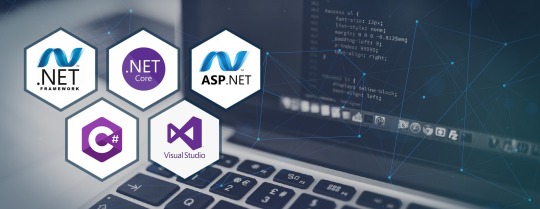
Seeree offers best .NET course in Bhubaneswar with 100% job assurance and low fee. Learn from real time corporate trainers and experienced faculties. Groom your personality with our faculty. Seeree helps to build confidence in students to give exposure to their skills to the company.
Course6:- SEO/Digital Marketing

In today's fast-paced digital world, businesses thrive on visibility, engagement, and strategic online presence. At SEEREE, we empower you with the skills and knowledge to master the art of Search Engine Optimization (SEO) and Digital Marketing.
Our comprehensive program is designed for beginners and professionals alike, covering everything from keyword research, on-page and off-page SEO, and content marketing, to social media strategies, PPC campaigns, and analytics.
With hands-on training, real-world projects, and guidance from industry experts, we ensure you're equipped to drive measurable results and excel in this dynamic field.
Join us at SEEREE Institute and take the first step towards becoming a leader in the digital marketing landscape!"
Course7:- SAP

SAP refers to Systems, Applications, and Products in Data Processing. Some of the most common subjects covered in these courses include human resource software administration, database management, and business training. Obtaining SAP certification can be done on a stand-alone basis or as part of a degree program.
Course8:- MERN

Seeree offers the best MERN course in Bhubaneswar with 100% job assurance and low fees. Learn from real-time corporate trainers and experienced faculty. Seeree helps students build confidence and gain skills to excel in company roles.
Are you ready to step into the exciting world of web development? At SEEREE, we bring you a comprehensive MERN Stack course that equips you with the skills to build modern, dynamic, and responsive web applications from start to finish.
The MERN Stack—comprising MongoDB, Express.js, React.js, and Node.js—is one of the most sought-after technologies in the web development industry. Our program is designed to help you master each component of the stack, from creating robust backends and managing databases to crafting dynamic frontends and seamless APIs.
Course9:- Software Testing
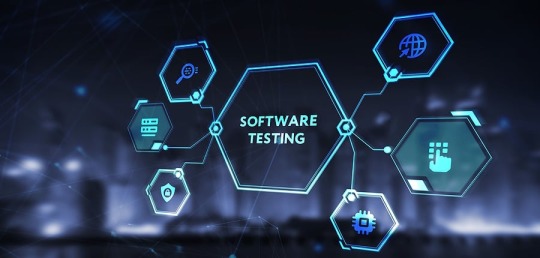
Seeree offers best Testing course in Bhubaneswar with 100% job assurance and low fee. Learn from real time corporate trainers and experienced faculties. Groom your personality with our faculty. Seeree helps to build confidence in students to give exposure to their skills to the company.
In the fast-paced world of software development, ensuring the quality and reliability of applications is crucial. At SEEREE, we offer a comprehensive Software Testing course designed to equip you with the skills and techniques needed to excel in this essential field.
Our program covers all aspects of software testing, from manual testing fundamentals to advanced automation tools and frameworks like Selenium, JIRA, and TestNG. You’ll learn to identify bugs, write test cases, execute test scripts, and ensure software meets high-quality standards.
With hands-on training, real-world scenarios, and guidance from experienced industry professionals, you’ll be prepared to take on roles like Quality Assurance Engineer, Test Analyst, and Automation Tester.
Join SEEREE Institute and gain the expertise to become a key player in delivering flawless software solutions. Your journey to a rewarding career in software testing starts here!"
Course10:- Data Analyst

Seeree offers the best Data Analyst course in Bhubaneswar with 100% job assurance and affordable fees. Our comprehensive curriculum is designed to cover all aspects of data analysis, from data collection and cleaning to advanced data visualization techniques. Learn from real-time corporate trainers and experienced faculty members who bring industry insights into the classroom. Enhance your analytical skills and boost your career prospects with hands-on projects and real-world case studies. Our faculty also focuses on grooming your personality and soft skills, ensuring you are well-prepared for interviews and workplace environments. Seeree is dedicated to building confidence in students, providing them with the necessary exposure to showcase their skills to top companies in the industry.
Course11:- Data Science
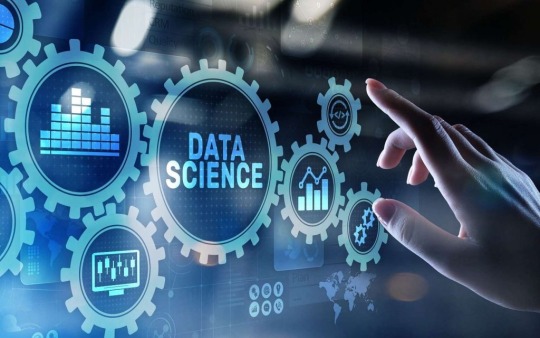
Seeree offers the best Data Science course in Bhubaneswar with 100% job assurance and affordable fees. Our comprehensive curriculum is designed to cover all aspects of data science, from data collection and cleaning to advanced data visualization techniques. Learn from real-time corporate trainers and experienced faculty members who bring industry insights into the classroom. Enhance your analytical skills and boost your career prospects with hands-on projects and real-world case studies. Our faculty also focuses on grooming your personality and soft skills, ensuring you are well-prepared for interviews and workplace environments. Seeree is dedicated to building confidence in students, providing them with the necessary exposure to showcase their skills to top companies in the industry.
Course12:- Data Engineering
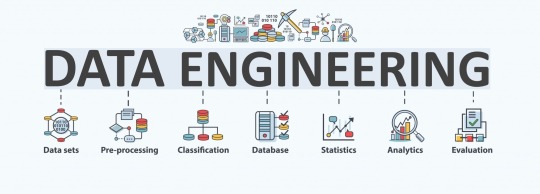
In the era of big data, the ability to design, build, and manage scalable data infrastructure is one of the most in-demand skills in the tech industry. At SEEREE, we are proud to offer a comprehensive Data Engineering course that prepares you for a career at the forefront of data-driven innovation.
Our program covers essential topics such as data modeling, ETL processes, data warehousing, cloud platforms, and tools like Apache Spark, Kafka, and Hadoop. You’ll learn how to collect, organize, and transform raw data into actionable insights, enabling businesses to make smarter decisions.
With real-world projects, expert mentorship, and hands-on experience with the latest technologies, we ensure that you are industry-ready. Whether you’re starting fresh or upskilling, this program will empower you to unlock opportunities in the rapidly growing field of data engineering.
Join SEEREE Institute and take the first step toward building the data pipelines that power tomorrow’s technology!"
Course13:- PGDCA

Seeree offers the best MERN course in Bhubaneswar with 100% job assurance and low fees. Learn from real-time corporate trainers and experienced faculty. Seeree helps students build confidence and gain skills to excel in company roles.
In today’s digital age, computer applications are at the heart of every industry, driving innovation and efficiency. At SEEREE Institute, our Post Graduate Diploma in Computer Applications (PGDCA) program is designed to provide you with in-depth knowledge and hands-on skills to excel in the IT world.
This program offers a comprehensive curriculum covering programming languages, database management, web development, software engineering, networking, and more. Whether you aim to enhance your technical expertise or step into a rewarding career in IT, PGDCA at SEEREE equips you with the tools to succeed.
With expert faculty, state-of-the-art labs, and real-world projects, we ensure that you gain practical experience and a strong theoretical foundation. By the end of the program, you’ll be prepared for roles such as software developer, system analyst, IT manager, or database administrator.
Course14:- Tally

Seeree offers the best Tally course in Bhubaneswar with 100% job assurance and low fees. Learn from real-time corporate trainers and experienced faculty. Seeree helps students build confidence and gain skills to excel in company roles.
In today’s business world, efficient financial management is key to success, and Tally is one of the most trusted tools for accounting and financial operations. At SEEREE Institute, we offer a comprehensive Tally course designed to equip you with the skills needed to manage business finances effortlessly.
Our program covers everything from the basics of accounting and bookkeeping to advanced features like GST compliance, inventory management, payroll processing, and generating financial reports. With hands-on training and real-world applications, you’ll gain practical expertise in using Tally effectively for businesses of any scale.
Whether you're a student, a professional, or a business owner, our Tally program is tailored to meet your needs and enhance your career prospects in the fields of accounting and finance.
Course15:- Graphics Design

In the world of creativity and communication, graphic design plays a vital role in bringing ideas to life. At SEEREE Institute, our Graphic Design course is tailored to help you unlock your creative potential and master the art of visual storytelling.
Our program covers a wide range of topics, including design principles, color theory, typography, branding, and user interface design. You’ll gain hands-on experience with industry-standard tools like Adobe Photoshop, Illustrator, and InDesign, enabling you to create stunning visuals for print, digital media, and beyond.
Whether you're an aspiring designer or a professional looking to sharpen your skills, our expert trainers and real-world projects will provide you with the knowledge and confidence to excel in this competitive field.
Join SEEREE Institute and start your journey toward becoming a skilled graphic designer. Let’s design your future together!"
2 notes
·
View notes
Text
NVIDIA AI Workflows Detect False Credit Card Transactions
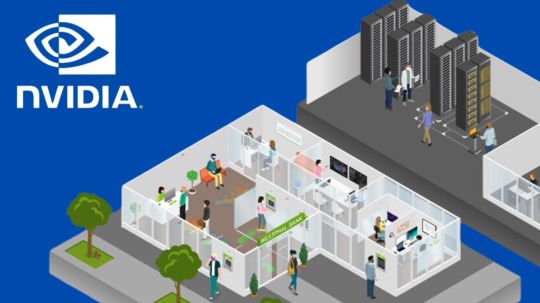
A Novel AI Workflow from NVIDIA Identifies False Credit Card Transactions.
The process, which is powered by the NVIDIA AI platform on AWS, may reduce risk and save money for financial services companies.
By 2026, global credit card transaction fraud is predicted to cause $43 billion in damages.
Using rapid data processing and sophisticated algorithms, a new fraud detection NVIDIA AI workflows on Amazon Web Services (AWS) will assist fight this growing pandemic by enhancing AI’s capacity to identify and stop credit card transaction fraud.
In contrast to conventional techniques, the process, which was introduced this week at the Money20/20 fintech conference, helps financial institutions spot minute trends and irregularities in transaction data by analyzing user behavior. This increases accuracy and lowers false positives.
Users may use the NVIDIA AI Enterprise software platform and NVIDIA GPU instances to expedite the transition of their fraud detection operations from conventional computation to accelerated compute.
Companies that use complete machine learning tools and methods may see an estimated 40% increase in the accuracy of fraud detection, which will help them find and stop criminals more quickly and lessen damage.
As a result, top financial institutions like Capital One and American Express have started using AI to develop exclusive solutions that improve client safety and reduce fraud.
With the help of NVIDIA AI, the new NVIDIA workflow speeds up data processing, model training, and inference while showcasing how these elements can be combined into a single, user-friendly software package.
The procedure, which is now geared for credit card transaction fraud, might be modified for use cases including money laundering, account takeover, and new account fraud.
Enhanced Processing for Fraud Identification
It is more crucial than ever for businesses in all sectors, including financial services, to use computational capacity that is economical and energy-efficient as AI models grow in complexity, size, and variety.
Conventional data science pipelines don’t have the compute acceleration needed to process the enormous amounts of data needed to combat fraud in the face of the industry’s continually increasing losses. Payment organizations may be able to save money and time on data processing by using NVIDIA RAPIDS Accelerator for Apache Spark.
Financial institutions are using NVIDIA’s AI and accelerated computing solutions to effectively handle massive datasets and provide real-time AI performance with intricate AI models.
The industry standard for detecting fraud has long been the use of gradient-boosted decision trees, a kind of machine learning technique that uses libraries like XGBoost.
Utilizing the NVIDIA RAPIDS suite of AI libraries, the new NVIDIA AI workflows for fraud detection improves XGBoost by adding graph neural network (GNN) embeddings as extra features to assist lower false positives.
In order to generate and train a model that can be coordinated with the NVIDIA Triton Inference Server and the NVIDIA Morpheus Runtime Core library for real-time inferencing, the GNN embeddings are fed into XGBoost.
All incoming data is safely inspected and categorized by the NVIDIA Morpheus framework, which also flags potentially suspicious behavior and tags it with patterns. The NVIDIA Triton Inference Server optimizes throughput, latency, and utilization while making it easier to infer all kinds of AI model deployments in production.
NVIDIA AI Enterprise provides Morpheus, RAPIDS, and Triton Inference Server.
Leading Financial Services Companies Use AI
AI is assisting in the fight against the growing trend of online or mobile fraud losses, which are being reported by several major financial institutions in North America.
American Express started using artificial intelligence (AI) to combat fraud in 2010. The company uses fraud detection algorithms to track all client transactions worldwide in real time, producing fraud determinations in a matter of milliseconds. American Express improved model accuracy by using a variety of sophisticated algorithms, one of which used the NVIDIA AI platform, therefore strengthening the organization’s capacity to combat fraud.
Large language models and generative AI are used by the European digital bank Bunq to assist in the detection of fraud and money laundering. With NVIDIA accelerated processing, its AI-powered transaction-monitoring system was able to train models at over 100 times quicker rates.
In March, BNY said that it was the first big bank to implement an NVIDIA DGX SuperPOD with DGX H100 systems. This would aid in the development of solutions that enable use cases such as fraud detection.
In order to improve their financial services apps and help protect their clients’ funds, identities, and digital accounts, systems integrators, software suppliers, and cloud service providers may now include the new NVIDIA AI workflows for fraud detection. NVIDIA Technical Blog post on enhancing fraud detection with GNNs and investigate the NVIDIA AI workflows for fraud detection.
Read more on Govindhtech.com
#NVIDIAAI#AWS#FraudDetection#AI#GenerativeAI#LLM#AImodels#News#Technews#Technology#Technologytrends#govindhtech#Technologynews
2 notes
·
View notes
Text
Big Data and AI: The Perfect Partnership for Future Innovations

Innovation allows organizations to excel at differentiation, boosting competitive advantages. Amid the growth of industry-disrupting technologies, big data analytics and artificial intelligence (AI) professionals want to support brands seeking bold design, delivery, and functionality ideas. This post discusses the importance of big data and AI, explaining why they matter to future innovations and business development.
Understanding Big Data and AI
Big data is a vast data volume, and you will find mixed data structures because of continuous data collection involving multimedia data objects. A data object or asset can be a document, an audio track, a video clip, a photo, or identical objects with special file formats. Since big data services focus on sorting and exploring data objects’ attributes at an unprecedented scale, integrating AI tools is essential.
Artificial intelligence helps computers simulate human-like thinking and idea synthesis capabilities. Most AI ecosystems leverage advanced statistical methods and machine learning models. Their developers train the AI tools to develop and document high-quality insights by processing unstructured and semi-structured data objects.
As a result, the scope of big data broadens if you add AI integrations that can determine data context. Businesses can generate new ideas instead of recombining recorded data or automatically filter data via AI-assisted quality assurances.
Why Are Big Data and AI Perfect for Future Innovations?
1| They Accelerate Scientific Studies
Material sciences, green technology projects, and rare disorder research projects have provided humans with exceptional lifestyle improvements. However, as markets mature, commoditization becomes inevitable.
At the same time, new, untested ideas can fail, attracting regulators’ dismay, disrespecting consumers’ beliefs, or hurting the environment. Additionally, bold ideas must not alienate consumers due to inherent complexity. Therefore, private sector stakeholders must employ scientific methods to identify feasible, sustainable, and consumer-friendly product ideas for brand differentiation.
AI-powered platforms and business analytics solutions help global corporations immediately acquire, filter, and document data assets for independent research projects. For instance, a pharmaceutical firm can use them during clinical drug formulations and trials, while a car manufacturer might discover efficient production tactics using AI and big data.
2| Brands Can Objectively Evaluate Forward-Thinking Business Ideas
Some business ideas that a few people thought were laughable or unrealistic a few decades ago have forced many brands and professionals to abandon conventional strategies. Consider how streaming platforms’ founders affected theatrical film releases. They have reduced the importance of box office revenues while increasing independent artists’ discoverability.
Likewise, exploring real estate investment opportunities on a tiny mobile or ordering clothes online were bizarre practices, according to many non-believers. They also predicted socializing through virtual reality (VR) avatars inside a computer-generated three-dimensional space would attract only the tech-savvy young adults.
Today, customers and investors who underestimated those innovations prefer religiously studying how disrupting startups perform. Brands care less about losing money than missing an opportunity to be a first mover for a niche consumer base. Similarly, rejecting an idea without testing it at least a few times has become a taboo.
Nobody can be 100% sure which innovation will gain global momentum, but AI and big data might provide relevant hints. These technologies are best for conducting unlimited scenario analyses and testing ideas likely to satisfy tomorrow’s customer expectations.
3| AI-Assisted Insight Explorations Gamifies Idea Synthesis
Combining a few ideas is easy but finding meaningful and profitable ideas by sorting the best ones is daunting. Innovative individuals must embrace AI recommendations to reduce time spent on brainstorming, product repurposing, and multidisciplinary collaborations. Furthermore, they can challenge themselves to find ideas better than an AI tool.
Gamification of brainstorming will facilitate a healthy pursuit of novel product features, marketing strategies, and customer journey personalization. Additionally, incentivizing employees to leverage AI and big data to experiment with designing methods provides unique insights for future innovations.
4| You Can Optimize Supply Chain Components with Big Data and AI Programs
AI can capture extensive data on supply chains and offer suggestions on alternative supplier relations. Therefore, businesses will revise supply and delivery planning to overcome the flaws in current practices.
For instance, Gartner awarded Beijing’s JD.com the Technology Innovation Award in 2024 because they combined statistical forecasting. The awardee has developed an explainable artificial intelligence to enhance its supply chain. Other finalists in this award category were Google, Cisco, MTN Group, and Allina Health.
5| Academia Can Embrace Adaptive Learning and Psychological Well-Being
Communication barriers and trying to force all learners to follow the standard course material based on a fixed schedule have undermined educational institutions’ goals worldwide. Understandably, expecting teachers to customize courses and multimedia assets for each student is impractical and humanly infeasible.
As a result, investors, policymakers, parents, and student bodies seek outcome-oriented educational innovations powered by AI and big data for a learner-friendly, inclusive future. For instance, some edtech providers use AI computer-aided learning and teaching ecosystems leveraging videoconferencing, curriculum personalization, and psycho-cognitive support.
Adaptive learning applications build student profiles and segments like marketers’ consumer categorizations. Their AI integrations can determine the ideal pace for teaching, whether a student exhibits learning disabilities, and whether a college or school has adequate resources.
Challenges in Promoting Innovations Based on Big Data and AI Use Cases
Encouraging stakeholders to acknowledge the need for big data and AI might be challenging. After all, uninformed stakeholders are likely to distrust tech-enabled lifestyle changes. Therefore, increasing AI awareness and educating everyone on data ethics are essential.
In some regions, the IT or network infrastructure necessary for big data is unavailable or prone to stability flaws. This issue requires more investments and talented data specialists to leverage AI tools or conduct predictive analyses.
Today’s legal frameworks lack provisions for regulating AI, big data, and scenario analytics. So, brands are unsure whether expanding data scope will get public administrators’ approvals. Lawmakers must find a balanced approach to enable AI-powered big data innovations without neglecting consumer rights or “privacy by design” principles.
Conclusion
The future of enterprise, institutional, and policy innovations lies in responsible technology implementations. Despite the obstacles, AI enthusiasts are optimistic that more stakeholders will admire the potential of new, disruptive technologies.
Remember, gamifying how your team finds new ideas or predicting the actual potential of a business model necessitates AI’s predictive insights. At the same time, big data will offer broader perspectives on global supply chains and how to optimize a company’s policies.
Lastly, academic improvements and scientific research are integral to developing sustainable products, accomplishing educational objectives, and responding to global crises. As a result, the informed stakeholders agree that AI and big data are perfect for shaping future innovations.
2 notes
·
View notes
Text
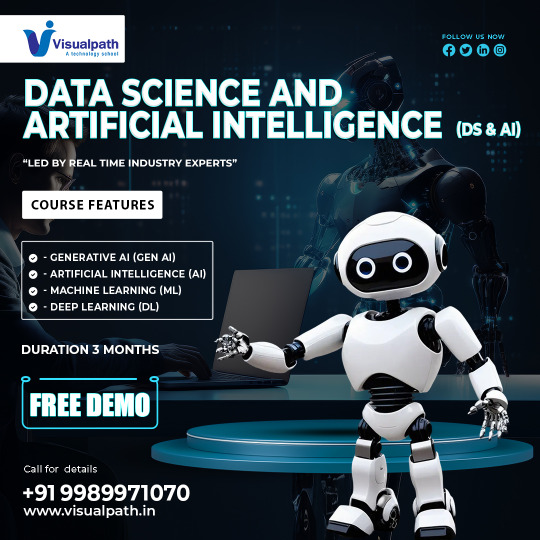
Data Science With Generative Ai Online Training | Generative Ai
Visualpath Offering Data Science With Generative Ai Online Training. elevate your career in data science. Our comprehensive Data Science With Generative Ai Combines advanced AI concepts and hands-on training to make you industry-ready. Enroll for a Free Demo. Call on: +91 9989971070
WhatsApp: https://www.whatsapp.com/catalog/919989971070/
Blog link: https://visualpathblogs.com/
Visit us: https://www.visualpath.in/online-data-science-with-generative-ai-course.html
#Data Science Course#Data Science Course In Hyderabad#Data Science Training In Hyderabad#Data Science With Generative Ai Course#Data Science Institutes In Hyderabad#Data Science With Generative Ai#Data Science With Generative Ai Online Training#Data Science With Generative Ai Course Hyderabad#Data Science With Generative Ai Training
0 notes
Text
Exploring Game-Changing Applications: Your Easy Steps to Learn Machine Learning:
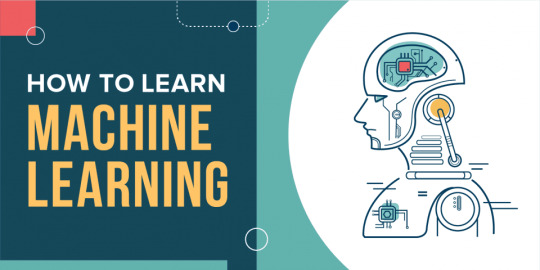
Machine learning technology has truly transformed multiple industries and continues to hold enormous potential for future development. If you're considering incorporating machine learning into your business or are simply eager to learn more about this transformative field, seeking advice from experts or enrolling in specialized courses is a wise step. For instance, the ACTE Institute offers comprehensive machine learning training programs that equip you with the knowledge and skills necessary for success in this rapidly evolving industry. Recognizing the potential of machine learning can unlock numerous avenues for data analysis, automation, and informed decision-making.
Now, let me share my successful journey in machine learning, which I believe can benefit everyone. These 10 steps have proven to be incredibly effective in helping me become a proficient machine learning practitioner:
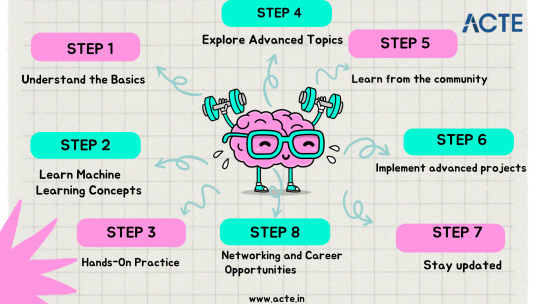
Step 1: Understand the Basics
Develop a strong grasp of fundamental mathematics, particularly linear algebra, calculus, and statistics.
Learn a programming language like Python, which is widely used in machine learning and provides a variety of useful libraries.
Step 2: Learn Machine Learning Concepts
Enroll in online courses from reputable platforms like Coursera, edX, and Udemy. Notably, the ACTE machine learning course is a stellar choice, offering comprehensive education, job placement, and certification.
Supplement your learning with authoritative books such as "Hands-On Machine Learning with Scikit-Learn, Keras, and TensorFlow" by Aurélien Géron and "Pattern Recognition and Machine Learning" by Christopher Bishop.
Step 3: Hands-On Practice:
Dive into real-world projects using both simple and complex datasets. Practical experience is invaluable for gaining proficiency.
Participate in machine learning competitions on platforms like Kaggle to challenge yourself and learn from peers.
Step 4: Explore Advanced Topics
Delve into deep learning, a critical subset of machine learning that focuses on neural networks. Online resources like the Deep Learning Specialisation on Coursera are incredibly informative.
For those intrigued by language-related applications, explore Natural Language Processing (NLP) using resources like the "Natural Language Processing with Python" book by Steven Bird and Ewan Klein.
Step 5: Learn from the Community
Engage with online communities such as Reddit's r/Machine Learning and Stack Overflow. Participate in discussions, seek answers to queries, and absorb insights from others' experiences.
Follow machine learning blogs and podcasts to stay updated on the latest advancements, case studies, and best practices.
Step 6: Implement Advanced Projects
Challenge yourself with intricate projects that stretch your skills. This might involve tasks like image recognition, building recommendation systems, or even crafting your own AI-powered application.
Step 7: Stay updated
Stay current by reading research papers from renowned conferences like NeurIPS, ICML, and CVPR to stay on top of cutting-edge techniques.
Consider advanced online courses that delve into specialized topics such as reinforcement learning and generative adversarial networks (GANs).
Step 8: Build a Portfolio
Showcase your completed projects on GitHub to demonstrate your expertise to potential employers or collaborators.
Step 9: Network and Explore Career Opportunities
Attend conferences, workshops, and meetups to network with industry professionals and stay connected with the latest trends.
Explore job opportunities in data science and machine learning, leveraging your portfolio and projects to stand out during interviews.
In essence, mastering machine learning involves a step-by-step process encompassing learning core concepts, engaging in hands-on practice, and actively participating in the vibrant machine learning community. Starting from foundational mathematics and programming, progressing through online courses and projects, and eventually venturing into advanced topics like deep learning, this journey equips you with essential skills. Embracing the machine learning community and building a robust portfolio opens doors to promising opportunities in this dynamic and impactful field.
9 notes
·
View notes
Text
Leveraging AI and Machine Learning Capabilities in Power BI
The integration of Artificial Intelligence (AI) and Machine Learning (ML) in business intelligence tools has revolutionized data analysis and decision-making processes. Among these tools, Power BI stands out by offering robust capabilities to harness the power of AI and ML. As businesses strive to gain deeper insights and improve their operations, learning how to leverage these capabilities in Power BI is becoming essential. For those aspiring to build a career in Power BI, there are various top Power BI institutes that provide comprehensive training and certification programs.
Enhancing Data Analysis with AI in Power BI
Power BI's AI features enhance data analysis by providing advanced data modeling, natural language processing, and predictive analytics. Users can effortlessly analyze large datasets and uncover patterns that would be challenging to detect manually. By enrolling in a Power BI course with job assistance, individuals can gain practical experience in utilizing these AI capabilities to transform raw data into actionable insights. This knowledge is invaluable for those seeking to enhance their career in Power BI.
Utilizing Machine Learning Models in Power BI
Integrating machine learning models in Power BI enables users to predict future trends and behaviors based on historical data. Power BI supports various machine learning models, including regression, classification, and clustering. These models can be imported from platforms like Azure Machine Learning or created directly within Power BI. A comprehensive Power BI course at a reputable Power BI training institute will cover the integration and application of these models, preparing students for real-world data science challenges.
Building Custom AI Visuals
One of the standout features of Power BI is the ability to create custom AI visuals. These visuals leverage machine learning algorithms to provide deeper insights and predictive analytics directly within Power BI reports. For instance, the Key Influencers visual helps identify factors that influence specific outcomes, while the Decomposition Tree visual allows users to break down data hierarchies. By obtaining a Power BI certification program, individuals can demonstrate their expertise in creating and utilizing these advanced visuals, thereby boosting their career prospects in Power BI.
Automating Insights with Power BI and AI
AI-powered automation in Power BI streamlines the process of generating insights and reports. Features like the Q&A visual use natural language processing to allow users to ask questions and get answers directly from their data. This democratizes data access and makes it easier for non-technical users to derive insights. A Power BI course that includes AI training equips learners with the skills needed to leverage these automation features, enhancing their ability to deliver value to organizations.
Real-Time Data Analysis with AI
In today's fast-paced business environment, real-time data analysis is crucial for making timely decisions. Power BI's AI capabilities facilitate real-time data analysis by processing streaming data and providing up-to-the-minute insights. This is particularly useful for industries like finance and retail, where immediate data-driven decisions can have a significant impact. Those interested in a career in Power BI can benefit from enrolling in a top Power BI online training course with job assistance, which often includes training on real-time data analysis and AI integration.
Improving Data Accuracy with AI
Data accuracy is vital for reliable business intelligence. Power BI's AI tools help improve data accuracy by detecting anomalies and outliers, ensuring that the data used for analysis is clean and reliable. Advanced AI features like automatic data cleaning and data validation are covered in depth in courses offered by top Power BI institutes. This training helps professionals enhance their data preparation skills, a critical aspect of a successful career in Power BI. Leveraging AI and machine learning capabilities in Power BI significantly enhances the data analysis process, providing businesses with deeper insights and predictive analytics. For individuals looking to build a career in Power BI, enrolling in a Power BI training institute and obtaining a Power BI certification is a strategic step. These educational programs cover the integration of AI and ML in Power BI, equipping learners with the skills needed to excel in the field. Whether it's creating custom AI visuals, automating insights, or improving data accuracy, mastering these capabilities can set professionals apart in the competitive job market. By choosing a Power BI course with job assistance, individuals can ensure they are well-prepared to leverage AI and ML capabilities in Power BI, thereby enhancing their career prospects and contributing to the success of their organizations.
1 note
·
View note
Text
I'm so glad that generative AI is dying, but please please please understand that chatbot AIs and art generation AIs and voice replicating AIs are not the ones I'm scared of, they're just the most gimmicky, and the easiest to fight in a court of law.
You should be concerned with facial recognition software being used in policing. Many of these AIs are trained on datasets of majority white males, meaning they become less accurate and less effective when used on someone outside of those demographics, meaning more innocent people of marginalized communities being accused and harassed by police.
You should be concerned with resume-reading AI. Amazon created an AI model that was trained on previous hiring data and used to filter out applications. The software recognized a pattern of applicants with non-white names being rejected and thus filtered out every applicant with any non-white name. This software was deemed a failure by Amazon and was scrapped, but highlights a big issue with AI in general. If there's a shred of bias in a testing dataset, that bias will be amplified by the software.
You should be concerned with autonomous weaponry used in warfare. See, when I say "I want fewer people to die in war", it's because I want less war. What I don't want is for large wealthy imperialist countries to be putting lethal weapons with little to no human oversight into warzones where they can 'identify enemy combatants' and 'eliminate targets' at the discretion of a computer program. You know it's bad when even Elon Musk has publicly supported a ban on autonomous weaponry.
You should be concerned with AIs being trained to diagnose medical problems. These AIs are being trained on diagnosis data of previous medical cases. Meaning using patient data for a testing dataset (HIPAA/PIPEDA/GDPR etc. violations??). Anyone who's been tossed around the medical system could tell you that removing the humanity from healthcare will only lead to more suffering.
These are only a few examples I know off the top of my head as someone studying computer science in undergrad. This isn't to say that all AI is bad. AI is such a huge category of software that lumping it all together is irresponsible. AI is used in maps and navigation, spellcheck, translation software, speech-to-text, text-to-speech, online banking, malware detection, hate speech filtering, and so many assistive technologies for disabled people.
I'm glad that chatGPT and AI art generators are dying, but they're barely even on my list of concerns when it comes to AI technology.
#AI#AI technology#chatGPT#dall-e 2#AI art#AI ethics#facial recognition#AWS#AIart#AI tech#artificial intelligence
4 notes
·
View notes
Text

TOP 10 courses that have generally been in high demand in 2024-
Data Science and Machine Learning: Skills in data analysis, machine learning, and artificial intelligence are highly sought after in various industries.
Cybersecurity: With the increasing frequency of cyber threats, cybersecurity skills are crucial to protect sensitive information.
Cloud Computing: As businesses transition to cloud-based solutions, professionals with expertise in cloud computing, like AWS or Azure, are in high demand.
Digital Marketing: In the age of online businesses, digital marketing skills, including SEO, social media marketing, and content marketing, are highly valued.
Programming and Software Development: Proficiency in programming languages and software development skills continue to be in high demand across industries.
Healthcare and Nursing: Courses related to healthcare and nursing, especially those addressing specific needs like telemedicine, have seen increased demand.
Project Management: Project management skills are crucial in various sectors, and certifications like PMP (Project Management Professional) are highly valued.
Artificial Intelligence (AI) and Robotics: AI and robotics courses are sought after as businesses explore automation and intelligent technologies.
Blockchain Technology: With applications beyond cryptocurrencies, blockchain technology courses are gaining popularity in various sectors, including finance and supply chain.
Environmental Science and Sustainability: Courses focusing on environmental sustainability and green technologies are increasingly relevant in addressing global challenges.
Join Now
learn more -
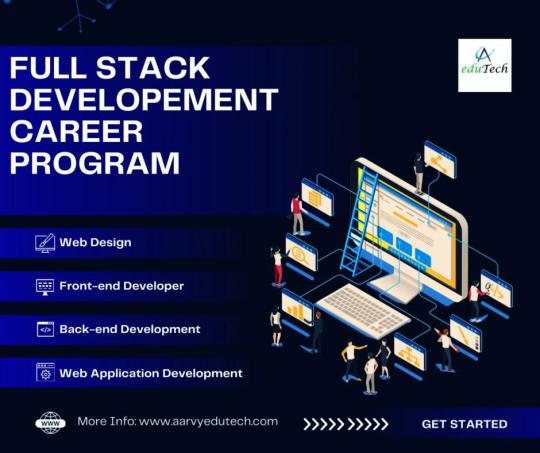
#artificial intelligence#html#coding#machine learning#python#programming#indiedev#rpg maker#devlog#linux#digital marketing#top 10 high demand course#Data Science courses#Machine Learning training#Cybersecurity certifications#Cloud Computing courses#Digital Marketing classes#Programming languages tutorials#Software Development courses#Healthcare and Nursing programs#Project Management certification#Artificial Intelligence courses#Robotics training#Blockchain Technology classes#Environmental Science education#Sustainability courses
2 notes
·
View notes
Text
There is such a massive, massive difference between how machine learning/"AI"** is used in scientific fields compared to the way large language models/generative "AI" programs are currently marketed to and used by the masses.
Like, y'all remember the post that went around a couple of years ago about the program that was created to distinguish between pastries in Japanese bakeries that was weirdly good at distinguishing between cancer cells and normal cells? That's machine learning at work. That's "AI".
The science behind machine learning/"AI" is really fascinating. The programs identify patterns in datasets and use that information to either find other datasets fitting said patterns or to make future predictions, which is really helpful in fields where massive data sets are common. Humans can only do so much when looking at hundreds of data points, much less when you get into the millions and billions. Some patterns are quickly recognizable; others aren't. And some patterns are so subtle that a human could not be expected to detect them as precisely as a program trained to detect the pattern could.
When you get into the science behind these programs, it's also really easy to see why they suck at artistic endeavors. Because they're looking for patterns using a ton of data points and trying to guess what "should" go next. And that's not really something you can do with creative works while maintaining high quality results. Because a lot of artists want to defy expectations or want to emphasize something they find personally moving or interesting, and that's what makes their art beautiful -- the intent behind the choices, the humanness of it all.
The programs are pretty terrible at creative writing for the same reasons. Writers are not generally just choosing any words that will communicate what's going on in a scene; they may choose different words depending on the point-of-view character and their background; they may choose different words depending on the state of mind of the point-of-view character in one scene vs. another. Large language models can't reason, so while they can communicate what's going on in a scene, they aren't going to be able to evoke the same feelings in the reader that a human writer can with word choice. And since writers are often infusing their work with underlying ideas and themes, choosing to emphasize one thing over another on purpose, the "AI"-written creative works are going to be found lacking every time. Because they have no reason to make one decision over another when it comes to word choice, tone, etc. if the words are technically communicating the same idea.
The reason large language models suck as search engines is for...you guessed it: the same reason. The model has been trained on the contents of the internet to develop a human-like writing capability. When you ask it a question, it's looking for a pattern to fill in the gaps. Which means the information it spits out just has to match that pattern. And since the pattern it's looking for is primarily just...sounding like a human wrote it, it can spit total nonsense out, and as long as that nonsense is...grammatically correct and sounds like a human wrote it, it technically did its job. Yes, sometimes the information it supplies is correct, because it's looking for the most-common responses and there are obviously times when the most-common pieces of information found online about a particular topic are 100% correct. But any time you ask an LLM a question, you are playing Family Feud with the Internet; it's going to give you its best guess for the most-common answer, not the most-correct answer.
What's so frustrating is that this sort of technology could be marketable for the masses while still being used properly and maintaining an accurate understanding of what it does! Like, if people are bound and determined to make a profit off of it, it could be done (and probably is being done tbh, whether the buzzwords are being used or not)! But I imagine that would take more work than just spitting out nonsense that sounds like a real sentence or pictures that are the embodiment of the W.C. Fields quote, “If you can't dazzle them with brilliance, baffle them with bullshit.” Because these models have to be specifically trained for what you're trying to accomplish with them if you want accurate conclusions to be drawn from the data, and why do that when you can just allow customers to misuse technology to their own detriment while you reap the profits of their ignorance?
**I am putting "AI" in quotes because the term implies the ability to reason independently, which none of these programs can do, and I'm salty about this and probably will be until the day I die.

(Source)
73K notes
·
View notes
Text
Top Generative AI Courses in Bengaluru for 2025: A Curated Guide for Future Innovators
As India’s tech capital, Bengaluru has always been a hub for innovation, software development, and data science. In 2025, it’s now leading a new frontier — Generative Artificial Intelligence. From startups leveraging AI to generate personalized content to enterprises automating workflows using large language models, the demand for skilled professionals in generative AI has surged.
If you are looking to gain hands-on experience and launch a high-growth career in this domain, Generative AI courses in Bengaluru are your ideal starting point. This guide curates the best programs available today to help you choose the right path toward becoming a generative AI expert.
Why Learn Generative AI in 2025?
The impact of generative AI is rapidly expanding across industries, transforming the way businesses create content, interact with customers, and automate tasks. Here’s why enrolling in a generative AI course in Bengaluru in 2025 is a smart move:
Significant demand across sectors including IT, fintech, marketing, and education
Integration of advanced AI tools like ChatGPT, Claude, and Stable Diffusion in daily workflows
Increased funding in AI startups and product development in Bengaluru’s startup ecosystem
Lucrative roles such as Prompt Engineer, LLM Developer, and AI Product Manager
Access to a vibrant tech community, meetups, and innovation labs across the city
Boston Institute of Analytics – Generative AI Certification Program
Mode: Hybrid (Offline + Online) Duration: 3 to 4 Months Location: Indiranagar, Bengaluru
Overview: Boston Institute of Analytics (BIA) offers one of the most industry-relevant Generative AI courses in Bengaluru, combining classroom training, online learning, and live projects. This program is designed to prepare students for careers in AI application development and research.
What You'll Learn:
Foundations of generative models (GANs, VAEs, Transformers)
Hands-on training with GPT models, DALL·E, Midjourney, and Sora
Prompt engineering techniques for content, code, and design generation
Building and deploying AI-powered applications
Ethics and challenges of generative AI
Key Features:
Global faculty and AI industry mentors
Internship and placement assistance in top tech companies
Access to AI tools and datasets
Certification recognized internationally
Ideal For: Students, tech professionals, entrepreneurs, and researchers looking to gain hands-on exposure with real-world AI tools.
What to Consider Before Enrolling?
When selecting the right Generative AI course in Bengaluru, evaluate the following factors:
Curriculum relevance: Does the course teach modern tools like GPT-4, Sora, Midjourney, etc.?
Mode of delivery: Do you prefer classroom training, online sessions, or hybrid models?
Project experience: Are real-world projects or hackathons included?
Mentorship and placement: Does the course offer career support and mentoring in Bengaluru?
Credibility: Is the institution or platform recognized by industry professionals?
Career Paths After Completing a Generative AI Course
As generative AI continues to reshape industries, professionals with expertise in this field are in high demand. Completing a generative AI course equips you with skills in deep learning, natural language processing, image generation, and model fine-tuning—opening doors to diverse career opportunities. Below are some of the most promising paths you can pursue.
1. Machine Learning Engineer
A machine learning engineer designs, builds, and deploys AI models, including generative models like GPT, DALL·E, or diffusion models. This role requires a deep understanding of programming (typically Python), frameworks such as TensorFlow or PyTorch, and strong knowledge of algorithms. Companies in tech, finance, healthcare, and autonomous vehicles often hire ML engineers to integrate generative AI into products or workflows.
2. Data Scientist with Generative AI Focus
Data scientists use AI to analyze large datasets and uncover patterns. With generative AI skills, they can build models for predictive text, image synthesis, or data augmentation. These professionals work across industries—from marketing and retail to pharmaceuticals and logistics—helping businesses make data-driven decisions with enhanced AI tools.
3. AI Researcher
If you’re interested in pushing the boundaries of what generative AI can do, a role in research might be right for you. AI researchers often work in academia, research labs, or R&D departments, focusing on developing new architectures or improving existing models. This career requires strong mathematical skills and a passion for experimentation and innovation.
4. Creative Technologist / AI Artist
Generative AI has revolutionized creative industries. Artists, designers, and filmmakers are now using tools like generative adversarial networks (GANs) or diffusion models to create art, music, and video content. A creative technologist blends programming with artistic skills to develop new forms of expression using AI.
5. Product Manager – AI Tools
Product managers who understand generative AI are highly valued in tech companies. They bridge the gap between technical teams and business stakeholders, guiding the development of AI-powered products. Understanding generative models helps PMs align product features with customer needs and market trends.
6. AI Ethics and Policy Specialist
As AI becomes more influential, ethical considerations are critical. Specialists in AI ethics work to ensure fairness, transparency, and accountability in generative systems. This path is ideal for those interested in the societal impact of AI.
Final Thoughts
Generative AI is shaping the future of work, creativity, and business across the world. For aspiring professionals in Bengaluru, now is the ideal time to acquire these future-ready skills. Whether you're looking for a beginner-friendly introduction or an advanced hands-on bootcamp, the options listed above offer a pathway tailored to your goals.
Among them, the Boston Institute of Analytics stands out for its practical approach, placement support, and hybrid learning flexibility, making it a top choice for those serious about launching a career in generative AI.
Choose a course that aligns with your learning style, career aspirations, and technical foundation — and take the next step toward becoming a part of Bengaluru’s AI revolution.
#Generative AI courses in Bengaluru#Generative AI training in Bengaluru#Agentic AI Course in Bengaluru#Agentic AI Training in Bengaluru
0 notes
Text
Blended Learning 2.0: Combining AI, AR, and Real Teachers in Modern Education

Introduction
In the digital age, education is evolving faster than ever. Traditional classrooms are merging with advanced technologies, giving birth to Blended Learning 2.0—a model that combines the best of both worlds: human interaction and smart technology. In 2025, this approach is transforming how students learn, engage, and grow.
From AI-powered assessments to AR-based science labs, schools are creating immersive and flexible learning environments. This upgraded blended model isn’t about replacing teachers but empowering them to deliver more personalized, interactive, and effective education.
What is Blended Learning 2.0?
Blended Learning 2.0 is an enhanced educational approach that integrates:
Traditional face-to-face teaching
Artificial Intelligence (AI) tools
Augmented Reality (AR) simulations
Digital platforms for content delivery, evaluation, and collaboration
Unlike earlier e-learning models, Blended 2.0 focuses on real-time feedback, adaptive learning paths, and multisensory experiences. It adapts to each student’s pace, strengths, and interests.
Why Blended Learning is Evolving in 2025
1. Personalization through AI
AI tools now analyze a student’s progress and offer tailored content, helping them overcome specific learning gaps. These tools suggest practice questions, reading materials, and even revision timelines—based on data.
2. Engagement through AR/VR
Subjects like science, geography, and history come to life through 3D models and simulations. AR-based apps let students dissect virtual frogs, explore the human brain, or walk through ancient civilizations—all from their classrooms.
3. Flexibility and Accessibility
Students can access lectures, notes, and quizzes anytime, anywhere. This is especially helpful for:
Reviewing lessons before exams
Catching up after absences
Learning at one’s own pace
Key Components of Blended Learning 2.0
1. AI-Powered Learning Platforms
These platforms assess understanding through quizzes and activities and then suggest next steps. Some even generate reports for teachers and parents to monitor progress.
2. AR and VR Classrooms
Virtual reality helps simulate real-life environments for better retention and understanding. For example, students studying geography can take a virtual trip to the Arctic or Amazon.
3. Smart Classrooms
Equipped with interactive boards, tablets, and IoT tools, these classrooms foster two-way engagement. Teachers can track who’s participating, who’s struggling, and adjust accordingly.
4. Hybrid Schedules
Many schools are using blended formats for flexibility—combining in-school activities with online assignments and discussions.
The Role of Teachers in Blended 2.0
Technology may be powerful, but teachers remain the heart of the classroom. In Blended Learning 2.0:
Teachers act as facilitators, guiding students through digital content
They provide human feedback, emotional support, and critical thinking exercises
They use AI insights to modify lesson plans and target weak areas
Educators are being trained to harness these tools, not fear them.
Benefits of Blended Learning 2.0
1. Improved Learning Outcomes
Students grasp concepts faster when they learn through multiple methods—reading, watching, doing.
2. Higher Student Engagement
Interactive elements and gamified lessons keep learners interested and reduce distraction.
3. Real-Time Assessment
Teachers can immediately identify who needs help and who’s ready to move on.
4. Skill Building
Beyond academics, blended platforms promote digital literacy, time management, and self-learning.
Case in Point: Schools Leading the Change
Many progressive schools have already embraced this model. For instance, Bgs Vijnatham School, one of the best school in Noida Extension, integrates AI-driven tools and AR labs with traditional teaching to make learning fun, smart, and personalized.
Their students not only perform well academically but are also future-ready—equipped with skills in tech, communication, and critical thinking.
Challenges and How Schools Are Overcoming Them
While promising, Blended 2.0 comes with challenges:
Not all students have access to high-end devices or fast internet
Teachers need time and training to adapt
Parental involvement is crucial in home-based learning
Forward-thinking schools tackle these by:
Providing shared tablets or school-issued devices
Hosting digital literacy workshops for teachers and parents
Creating offline-compatible content for underserved students
What the Future Holds
Blended Learning 2.0 is not a stopgap solution—it’s the blueprint for education in the digital era. As AI and AR continue to evolve, we can expect:
Emotion AI to understand students’ moods
Voice-assisted learning for reading and language practice
AI mentors and peer-to-peer learning bots
Conclusion: Human + Technology = Smart Learning
Blended Learning 2.0 proves that the best education model is not one that chooses between teacher or tech—but one that brings them together. It enhances the human touch with intelligent systems, ensuring every student learns effectively and enjoys the process.
In 2025 and beyond, this model will continue to empower teachers, excite students, and reshape the very idea of a classroom.
Schools like Bgs Vijnatham School, one of the best school in Noida , are leading this wave of innovation—where curiosity is cultivated, technology is leveraged, and every learner is given the opportunity to thrive.
0 notes